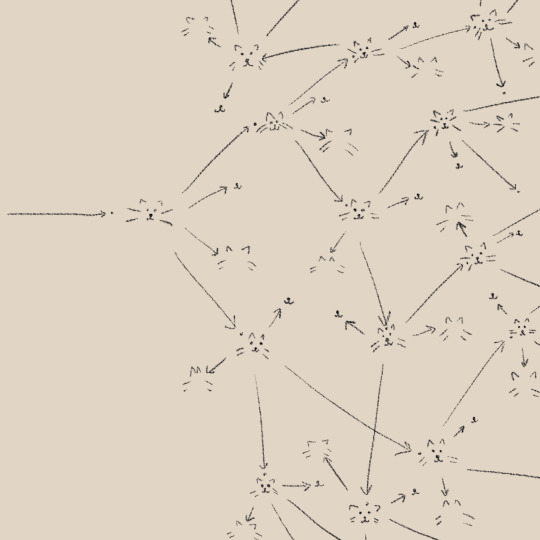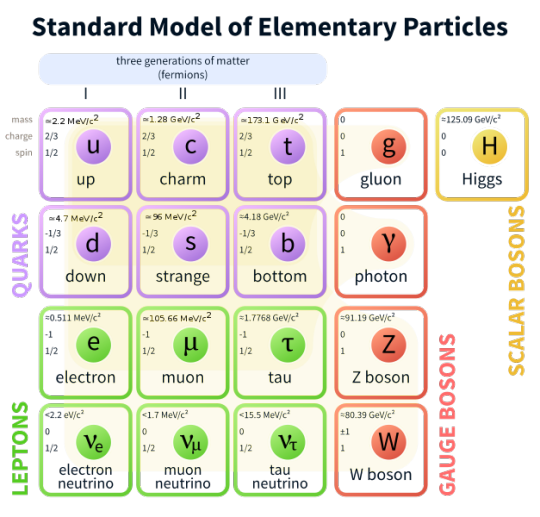#all it would take is one rogue neutron and BOOM
Text

I drew this diagram at 1 AM to show what I think it would look like if cats underwent explosive nuclear fission
#cats#science#diagram#art#silly cats#this could really happen#all it would take is one rogue neutron and BOOM#three meowle island
37 notes
·
View notes
Text
Time for some Particle Physics 101

No, not from you Tales of Suspense. There’s no such thing as “sub-anti-matter” particles. Antimatter? Totally a thing. Totally can interact with the electromagnetic force (and therefore radio waves). And as soon as it collides with the matter version of its particles, everything goes the biggest boom you’d ever see in your life.*
Wikipedia actually a nice handy breakdown of the types of fundamental particles, but it doesn’t mean much unless you already know what’s going on...at least a little bit.

Supposing you don’t remember any of your high school science classes, you should at least recognize two of these things - the electron and the photon. Maybe you’ve heard of the Higgs thing-y, but have no clue what it is, because it was in the news a few years ago.
Electrons and their heavier,** less stable, cousins “muons” and “tau particles” are all negatively charged, and all equally as negative (That’s the -1′s you see in their boxes). Together with the three “flavors” of neutrinos, they form the group physicists call leptons.
Neutrinos are produced as a byproduct of certain nuclear reactions, like radioactive decay and fusion. They’re cosmic ghosts, with basically no mass, and they’re capable of streaming through solid planets as if there’s nothing there. They’re electrically neutral (hence the name), so they don’t interact with the electromagnetic force. That means they - like the stuff this space ship is supposedly made of - wouldn’t interact with radio waves...because radio waves are electromagnetic waves.***
The next main group of particles is the quarks (not Armin Shimerman’s Quark, sadly). Most of the ones that exist currently in the universe are ups and downs, in the form of protons and neutrons. Protons are made of 2 ups + 1 down, and Neutrons are 2 downs + 1 up. Quarks can never exist as single particles; they always come in groups of 2 or more, because the amount of energy required to pull them apart will always be enough energy to create another quark that’s stuck to one you’re trying to isolate.
We call all composite quark particles - whether they’re protons, neutrons, or more exotic particles - hadrons. (If that word sounds familiar to you, you might be thinking of the LHC - the Large Hadron Collider - which is the large particle accelerator on the border of Switzerland and France.)
Particles made up of 2 quarks (specifically, one quark and one anti-quark) are called mesons, and particles made up of 3 quarks are called baryons.
Wait! Did I say “mesons”? That brings me to another panel in this issue...

I don’t know what an “ultra-meson” is, but you totally could invent a machine that fires out mesons. Unfortunately, all varieties of meson are super unstable, with the longest living a whopping nanosecond before they decay into electrons and neutrinos or photons.
The way to get around this is to make them travel at nearly the speed of light. Since the faster you travel the slower your internal clock appears to the rest of the universe (think: Special Relativity and Time Dilation), a super-super-speedy meson would appear to last longer to us. Maybe, like, a second or so.
But it looks like the baddie in this comic short has a weapon that won’t actually be as effective as he thinks it will be.
The remaining group of particles in the chart above are the bosons - the messenger particles for the fundamental forces in the universe. Photons pair with the electromagnetic force. Gluons pair with the strong nuclear force and are what hold quarks and hadrons together. The Gauge Bosons are particles that mediate radioactive decay for the weak nuclear force. And the Higgs is - as we understand it - what allows particles to have mass.
There’s a hypothetical particle for mediating gravity called the graviton, but no one’s ever actually detected it.
So that was the second story in Tales of Suspense #54 - a story about a lizard-like alien conqueror who gets scared of an old lady with a mink coat. The third is about the classic Marvel character Uatu the Watcher, who fails to intervene in protecting some aliens.
It actually turns out for the better.

Yeah - the aliens throw all their dangerous nuclear waste out into space for some other civilization to worry about.
(Why it got launched as a giant cloud, and not stored inside a large vat/rocket payload thing, is anyone’s guess.)
They aim their giant cloud for the “most deserted part of the galaxy”. We don’t know what galaxy they live in - whether it’s a spiral like the Milky Way, ellipsoidal, or something irregular like dwarf galaxies tend to be. We also don’t know where inside their galaxy their planet is located. If it’s like Earth’s situation, they’d be out in the boonies - located between two arms, and decently far from the super crowded center.

Wherever they’re located, they can only launch their giant cloud of radioactive junk at sub-light speeds, and space is very, very big. So it would certainly take more than a few decades before it ran into another system harboring life. But hey, they can’t even think to use an uninhabited planet in their system as a giant junk yard, so clearly they’re not all that clever.
But anyway, the cloud is heading for an inhabited system. Uatu struggles with the “no interference” rule his bosses have imposed, but he ultimately does nothing.
He also does nothing when a nearby supernova throws one of its planets toward the exact same system.

Turns out the two threats collide with one another, creating an explosion that literally obliterates the rogue planet.

Now, nuclear waste is waste for a reason - only certain isotopes are good for fission reactions, like Uranium-235 and Plutonium-239/241. After they break apart they don’t go boom again. You can’t make a nuclear bomb out of radioactive waste.
You can make a dirty bomb, though. Cobalt-60 is produced in nuclear reactors, and can be collected and put inside conventional explosives to add a radioactive health hazard, or inside another nuke to increase the radioactive fallout. But it itself doesn’t undergo a nuclear explosion.
Radioactive waste is dangerous because its atoms spit out small particles that have energies high enough to damage your cells and the DNA inside them. It’s not dangerous because it could undergo a second nuclear explosion.
So ignoring the fact that you would need a crazy amount of energy to obliterate an entire planet - you’d need 1,000,000 billion of history’s largest nuke Tsar Bomba detonating simultaneously at the center of the Earth, for example - this radioactive cloud couldn’t provide the fuel necessary for that “unimaginably powerful atomic explosion”.
But it does open up a good ice breaker question - would you rather die from your planet’s atmosphere getting polluted by radioactive fallout, or by having a giant space rock smash into you.
* Matter-antimatter collisions produce light, so you would indeed literally see it. And they’re the very best at converting mass into energy (unlike, e.g. nuclear fusion, chemical combustion) so gram for gram it’s the biggest boom.
** By ‘heavier’, I’m referring to mass, not weight. However in particle physics mass is always given in terms of energy equivalence, e.g. MeV/c^2. As an astrophysicist who never worked with high energy stuff, this still confuses me.
*** (They’re also photons - the particle versions of light.)
4 notes
·
View notes